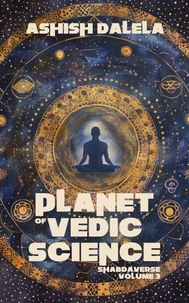Vaise?ika is one of the Six Systems of Vedic philosophy, and Vaise?ika Sutra is the oldest and most authoritative text on this philosophy. This book translates and comments on this ancient text. Vaise?ika describes all things in the world as Padartha-pada denotes a symbol and artha denotes its meaning. These symbols of meaning are created by the combination of Samanya and Vaisesa or universals and individuals.
These Padartha are connected to each other through a relationship of inherence called Samvaya, which we can call the whole-part relationship. Thus, one symbol represents the whole, and the other symbols connected to it through inherence constitute its parts. This whole-part relation between symbols of meaning is organized from whole to parts like an inverted tree in which the root is the whole, the branches are the parts of the root, the leaves are parts of the branches, etc. The universals are of three types-guna (qualities), kriya (activities), and dravya (object).
The activities and qualities inhere in the object, and they are manifest through interactions between symbols. We can measure the effects of interactions via physical instruments and convert the semantic reality to physical reality, but we can never explain these effects based on the quantities. This description of atomism in Vaise?ika helps us understand why modern scientific atomism is incomplete-it tries to explain effects measured using physical instruments in terms of physical objects and their properties, when the objects, their properties, and their effects must all be described as concepts.
Vaise?ika is one of the Six Systems of Vedic philosophy, and Vaise?ika Sutra is the oldest and most authoritative text on this philosophy. This book translates and comments on this ancient text. Vaise?ika describes all things in the world as Padartha-pada denotes a symbol and artha denotes its meaning. These symbols of meaning are created by the combination of Samanya and Vaisesa or universals and individuals.
These Padartha are connected to each other through a relationship of inherence called Samvaya, which we can call the whole-part relationship. Thus, one symbol represents the whole, and the other symbols connected to it through inherence constitute its parts. This whole-part relation between symbols of meaning is organized from whole to parts like an inverted tree in which the root is the whole, the branches are the parts of the root, the leaves are parts of the branches, etc. The universals are of three types-guna (qualities), kriya (activities), and dravya (object).
The activities and qualities inhere in the object, and they are manifest through interactions between symbols. We can measure the effects of interactions via physical instruments and convert the semantic reality to physical reality, but we can never explain these effects based on the quantities. This description of atomism in Vaise?ika helps us understand why modern scientific atomism is incomplete-it tries to explain effects measured using physical instruments in terms of physical objects and their properties, when the objects, their properties, and their effects must all be described as concepts.

 , qui est-ce ?
, qui est-ce ?